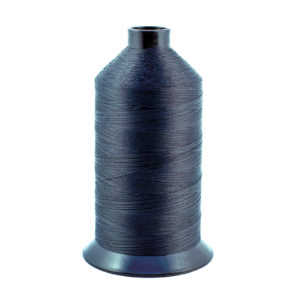
To sew or to seal is a question that some fabricators have answered by gearing their offerings toward products that utilize either the former or the latter, but not both. While this kind of specialization can be a viable and lucrative strategy, expanding the toolbox to incorporate both sewing and sealing can often prove even more profitable—under the right conditions.
There’s good reason to consider doing so, says Steven Kaplan, president of S. Kaplan Sewing Machine Co. Inc. Headquartered in Newark, N.J., the company is a worldwide distributer of heavy-duty sewing machines to non-apparel industries.
“For one thing, these aren’t mutually exclusive,” he says. “Sometimes a project will require sewing and sealing, so there’s a big place for both.”
But without adequate planning and preparation, the endeavor to become more versatile can backfire, resulting in businesses taking on expenses that don’t end up bringing in a good return on investment (ROI), especially if they have to hire more workers. Offering both can also mean entering somewhat unfamiliar manufacturing territory, leading to possible product failures; for example, when an item should have been sewn but was sealed instead, or vice versa. Evaluating, purchasing and learning to operate
new equipment has its own set of challenges. We’ve gathered some insights about these processes to help fabricators who may be perched atop the “should I or shouldn’t I?” fence.
Needle and thread
One advantage sewing offers is that virtually any fabric can be sewn, which isn’t necessarily the case when it comes to sealing, Kaplan says. Still, there are projects that call for a combined approach, which is why Kaplan says many of his customers offer both.
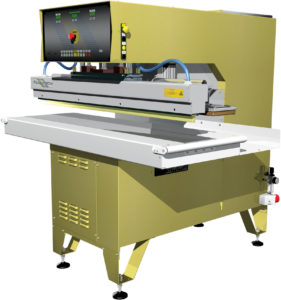
Take awnings, for example. Sewing will create holes in the fabric that could leak. Most of the time, this isn’t an issue—although for products ending up in marine environments, it could be a consideration. One approach is to seal the top panels of the awning, where the rain would hit, then sew around the sides.
There are threads available designed to prevent water leakage. Fil-Tec Inc., a Hagerstown, Md., manufacturer of industrial threads and bobbins for different sewing applications for the outdoor, marine, mil-spec and furniture markets, makes a thread system appropriate for products that need to be waterproof. Called Aqua-Seal, this thread seals the sewn seam when it comes into contact with moisture, preventing water leakage, says Freddie Groce, vice president of marketing.
“In sealing, you’re relying on the integrity of the fabric,” Kaplan continues. “For example, if the coating fails, you could have a seam failure. Still, where you have very long seams, such as a tarp, then sealing is probably the way to go. But when you get into the construction of an item—for example, if there are complicated corners, or straps, webbing, D-rings or zippers around the perimeter of an item, or multiple layers of fabric—that’s when, in general, sewing is better.”
The project’s scale is an important determining factor, says James Herstein, area sales manager for Matic S.A. “Smaller finishing requirements may stick with sewing,” he says. “Larger projects typically use sealing. Finishing will also factor in. Sewing creates holes, and thread type and color need to be considered.”
The textile’s makeup also factors in, he adds. PVC-coated and vinyl materials will weld. However, cottons, polyesters and acrylics will require welding tape to do so. Very thick and dense materials are difficult to sew, since needles may break in the effort; this is why vinyl, for example, is “almost universally sealed,” Herstein says.
Headquartered in Barcelona, Spain, Matic provides a range of finishing solutions for the textile industries, including cutting, welding and sewing. Core markets include sun protection and the soft-signage market. Among other sewing equipment, Matic offers the fully automatic, double-needle Orion sewing machine, designed for the joining and hemming of retractable awing panels. For the soft-signage market, the company carries the Cronos line of automated sewing solutions. Sealing solutions include the Ares Plus, an impulse welding machine. Available in a variety of sizes, it features interchangeable welding bars (also in various sizes) and a patented seamless technology that eliminates the shine that typically occurs when PVC-coated material is impulse welded, according to Herstein.
Sealing technologies
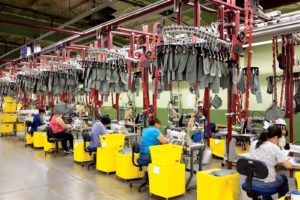
Vinyl Technology Inc., located in Monrovia, Calif., makes high-performance soft goods for the defense, aerospace and medical industries. Products include items like anti-G suits, fuel bladders, military dry bags and mattresses, and hazmat suits.
“Our expertise is in RF (radio frequency) heat sealing and industrial sewing of specialty films and fabrics,” says Carlos Mollura, vice president of sales and marketing. “Both [methods] are extremely versatile and valid ways of assembling fabrics. If a product needs to hold air, vacuum or fuel—like bladders, waterproof covers and hazmat suits—then it should be RF heat sealed. If it just needs to be assembled with uncoated fabric with no air or water retention required, you can sew the item.
“The biggest limitation to sealing fabrics is the type of coating to be sealed,” he says. “However, all uncoated fabrics can be sewn. Sewn applications can also be made airtight by applying a secondary layer over the stitch holes, for example with a seaming tape.”
According to Mollura, RF welding is the most popular method. Although this is mainly limited to PVC- and urethane-covered fabrics, some modifications can be made. Other sealing technologies include ultrasonic, hot air and impulse.
There are several reasons why RF welding is so often preferred. For one thing, the technology is reliable, says Eve Hawthorne, sales agent for Forsstrom HF and South Western High Frequency Inc. The welds are even and durable, delivering water-, air-, and gas-tight seals, and the process is speedy, with “superior repeatability.” At the same time, Hawthorne acknowledges there are benefits associated with sewing.
“Sewing serves non-apparel markets using fabrics such as canvas and leather that RF can’t weld,” she explains. “But a downside to sewing is the seams aren’t water-, air- or gas-tight, and the stitching is a stress and wear point.”
Forsstrom HF, headquartered in Lysekil, Sweden, provides a variety of RF welding machines, such as the Forsstrom TX Stationary welder. Designed to stand alone or complement a larger system of welding machines, the three-sided machine is used to manufacture products utilizing high-quality PVC and heavy PVC materials, like tents and inflatable products.
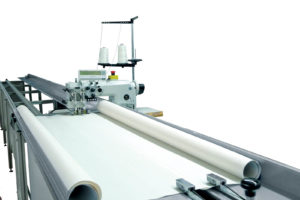
The company also offers the Forsstrom TDW Travelling welders, high-precision, easily adjustable machines used for manufacturing PVC and polyurethane (PU) products with long, straight welds, like tents and structures, oil booms and truck covers, and for large-scale production. (Forsstrom High Frequency is the company’s U.S. location; South Western High Frequency is authorized to represent, sell, maintain and service equipment in the U.S. for Forsstrom. Both are in Santa Fe Springs, Calif.)
Although most often used on PVC- or PU-coated fabrics, other materials such as polyethylene terephthalate (PET) and most polylactic acid (PLA) are RF weldable, says Traci Evling, managing director for JTE Machines LLC. These materials are mainly used in medical or packaging applications, she adds.
“Ultrasonic technology works well with PE [polyethylene] and PP [polypropylene] fabrics, as well as on thin-coated materials,” Evling says. “Acrylic material needs seaming tape with all welding processes; hot-air welding works well with PE-, PVC- and PU-coated materials, while impulse welding works with PP and other material with seam tape, but on linear welds only.
“The shape of the weld also determines which welding technology should be used,” she continues. “For example, variable curved welds usually require a rotary method—available only in hot air or ultrasonic—while multilayer and shaped stamped welding requires a platen using RF welding.”
Located in Orange Park, Fla., JTE Machines makes RF welding and ultrasonic welding and cutting machines for the industrial fabrics industry. The company also designs and provides tooling and fixtures for these machines, and provides training and education as well as follow-up services. Products include the JTE RF Double Welder, configured to allow two operators at the same time; the JTE Rotary Sonic Sew-n-Cut Welder, an ultrasonic sewing system for welding and trimming polyester flags, banners and signs; and the JTE Ultrasonic Automatic Weld and Cut, designed to cut and weld the edges of a variety of materials using ultrasonic technology across the entire vacuum table.
Decisions, decisions
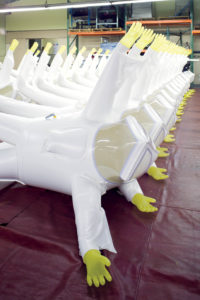
Many realities factor into the decision about whether it makes sense to add sewing or sealing to your menu of services. One of these is the kind of projects you anticipate attracting by doing so. For example, says Evling, welded seams, rather than sewn, are typically superior for products that must be water -or air-tight. They’re also likely the best route for medical applications involving antimicrobial requirements. Products destined for extreme weather are also good candidates for welding, she says, as thread might be prone to degradation under particularly harsh conditions.
“In fact, a welded seam can be stronger at the seam than the one-ply material itself,” Evling says. “While many threads are very strong today, the fact that the material must be punctured in a sewing process makes it weaker at each stitch point.”
On the other hand, Evling adds, materials requiring a stretch at the seam might be better sewn, since a welded seam won’t stretch.
Purchase costs are generally less for sewing machines, says Kaplan. But sewing equipment can generate other expenses, such as thread. Labor is also a consideration, although this depends on the machine.
“Automated sewing and welding solutions don’t require a skilled operator, so labor costs can be reduced with these machines,” Herstein explains. “Manual sewing typically carries the highest long-term labor costs. But one thing to consider is maintenance. Sewing machines require consistent maintenance and adjustment to keep the machine running properly.”
If a sewing machine breaks down, specialized services are typically necessary to get it back up and running, which can affect production, Herstein says. However, sealing solutions need much less attention, perhaps requiring servicing once a year or so, which can usually be managed in-house at a time when production won’t be affected.
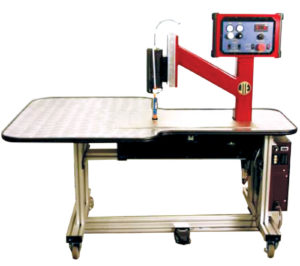
Still, the fact that, as Kaplan and Groce say, all fabrics can be sewn provides a compelling argument for taking the needle and thread approach, especially since sewn repairs to seams are easier to make than welding repairs, says Groce. Additionally, says Mollura, many fabrics lack a PVC or PU coating and, therefore, must be sewn.
Currently, sewing is more common than sealing, mainly because it’s been around longer and the cost of entry is lower, says Herstein. But, he adds, as a fabricator’s business grows, it’s common to add sealing solutions to the operation’s production capabilities. Evling anticipates that more fabricators will look to welding.
“As the availability of qualified, skilled sewing machine operators becomes more and more scarce, and with the continued innovation in advanced textiles, welding continues to grow in popularity and is often preferred over sewing wherever feasible,” she says.
Still, as Kaplan previously observed, there is room—and a need—for each method, something any manufacturer of textile products should take into account.
“In today’s economy, the ability to do both is something a fabricator should have in order to be competitive,” he says. “You don’t want to have to turn work away; you need the flexibility that both offer.”
For the uninitiated, fabric welding terminology can require some explanation. Here’s a quick glossary of the processes mentioned in this article (there are other technologies available):
Hot air welding deploys a precise combination of heat, speed and pressure to weld materials. During the welding process, heat is provided by compressed air blowing across electrical heat elements and is injected at the welding point.
Impulse welding is a hot-bar method of welding. These machines apply pressure to the seams using impulse-heating bars, creating heat by pushing energy through heating elements in the top and bottom bars. After the weld is finished, liquid is flushed through the bars, allowing
for a cool-down cycle.
RF (radio frequency) welding joins materials together by supplying high-frequency (HF) in the form of an electromagnetic field and pressure to the surfaces of the material to be joined. Energy is produced by a generator, supplied through an electrode tool. Electrical energy causes molecules within the material to start moving, generating heat that causes the material to soften and fuse together. No outside heat is required.
Ultrasonic welding uses high-frequency sound waves and pressure to bond materials.
 TEXTILES.ORG
TEXTILES.ORG


